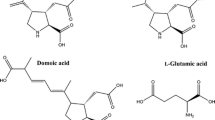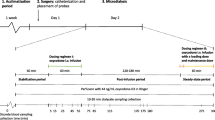Abstract
In vivo transport through the blood–brain barrier (BBB) has been demonstrated for a dynorphin-like analgesic peptide, CH3-[125I]Tyr-Gly-Gly-Phe-Leu-Arg-CH3Arg-D-Leu-NHC2H5 ([125I]E-2078). A remarkable time-dependent increase in the distribution volume of [125I]E-2078 in the brain parenchyma separated from blood vessels and capillaries was observed during a brain perfusion. The distribution volume of [125I]E-2078 in the brain parenchyma after 20 min of perfusion was 2.18 ± 0.09 µl/g brain (mean ± SE) and was significantly greater than the distribution volume of [3H]inulin (0.994 ± 0.138 (µl/g brain), providing in vivo evidence for the penetration of [125I]E-2078 into the brain parenchyma. Brain microdialysis was carried out to collect directly the brain interstitial fluid (ISF) during the brain perfusion of [125I]E-2078. No metabolite of [125I]E-2078 in the brain ISF was found by high-performance liquid chromatographic analysis of the brain dialysate. The concentrations of [125I]E-2078 and [14C]sucrose in the brain ISF were estimated based on an in vitro evaluation of dialysis clearance. The concentration ratio of [125I]E-2078 between the brain ISF and the brain perfusate was determined to be 2.92 × 10−l ± 0.50 × 10−l and was approximately 100 times higher than that of [14C]sucrose (2.71 × 10−3 ± 1.43 × 10−3), demonstrating transport of [125I]E-2078 through the BBB in vivo. On the other hand, no remarkable difference in the cerebrospinal fluid (CSF)-to-perfusate concentration ratios of [125I]E-2078 and [14C]sucrose was observed, indicating little contribution of the blood–CSF barrier (BCSF barrier) transport to the penetration of [125I]E-2078 into the brain.
Similar content being viewed by others
REFERENCES
A. K. Kumagai, J. B. Eisenberg, and W. M. Pardridge. Absorptive-mediated endocytosis of cationized albumin and a β-endorphin-cationized albumin chimeric peptide by isolated brain capillaries: Model system of blood-brain barrier transport. J. Biol. Chem. 262:15214–15219 (1987).
K. R. Duffy, W. M. Pardridge, and R. G. Rosenfeld. Human blood-brain barrier insulin-like growth factor receptor. Metabolism 37:136–140 (1988).
T. Terasaki, K. Hirai, H. Sato, Y. S. Kang, and A. Tsuji. Absorptive-mediated endocytosis of a dynorphin-like analgesic peptide, E-2078, into the blood-brain barrier. J. Pharmacol. Exp. Ther. 251:351–357 (1989).
W. H. Oldendorf. Measurement of brain uptake of radiolabeled substances using a tritiated water internal standard. Brain Res. 24:372–376 (1970).
U. Ungerstedt, M. Herrera-Marschitz, U. Jungnelius, L. Stahle, U. Tossman, and T. Zetterström. Dopamine synaptic mechanisms reflected in studies combining behavioral recordings and brain dialysis. Adv. Biosci. 37:219–231 (1982).
Y. Takasato, S. I. Rapoport, and Q. R. Smith. An in situ brain perfusion technique to study cerebrovascular transport in the rat. Am. J. Physiol. 247:H484–H493 (1984).
H. Benveniste, J. Drejer, A. Schousboe, and N. H. Diemer. Elevation of the extracellular concentrations of glutamate and aspartate in rat hippocampus during transient cerebral ischemia monitored by intracerebral microdialysis. J. Neurochem. 43:1369–1374 (1984).
J. B. Fishman, J. B. Rubin, J. V. Handrahan, J. R. Conner, and R. E. Fine. Receptor-mediated transcytosis of transferrin across the blood-brain barrier. J. Neurosci. Res. 18:299–304 (1987).
D. Triguero, J. Buciak, and W. M. Pardridge. Capillary depletion method for quantification of blood-brain barrier transport of circulating peptides and plasma proteins. J. Neurochem. 54:1882–1888 (1990).
S. Tachibana, H. Yoshino, Y. Arakawa, T. Nakazawa, S. Araki, T. Kaneko, and K. Yamatsu. A novel analogue (E-2078) of dynorphin (1): Design and structure-activity relationship. Int. Narcotics Res. Conf., 1987, p. 60.
T. Nakazawa, Y. Furuya, T. Kaneko, K. Yamatsu, H. Yoshino, and S. Tachibana. Analgesia produced by E-2078, a systemically active dynorphin analog, in mice. J. Pharmacol. Exp. Ther. 252:1247–1254 (1990).
Y. S. Kang, T. Terasaki, and A. Tsuji. Dysfunction of choline transport system through blood-brain barrier in stroke-prone spontaneously hypertensive rats. J. Pharmacobio-Dyn. 13:10–19 (1990).
W. M. Pardridge and G. Fierer. Blood-brain barrier transport of butanol and water relative to N-isopropyl-p-iodoamphetamine as the internal reference. J. Cereb. Blood Flow Metab. 5:275–281 (1985).
R. C. Chou and G. Levy. Effect of heparin or salicylate infusion on serum protein binding and on concentrations of phenytoin in serum, brain and cerebrospinal fluid of rats. J. Pharmacol. Exp. Ther. 219:42–48 (1981).
W. M. Pardridge. Receptor-mediated peptide transport through the blood-brain barrier. Endocrine Rev. 7:314–330 (1986).
W. M. Pardridge and L. J. Mietus. Enkephalin and blood-brain barrier: Studies of binding and degradation in isolated brain microvessels. Endocrinology 109:1138–1143 (1981).
W. M. Pardridge. Brain metabolism: A perspective from the blood-brain barrier. Physiol. Rev. 63:1481–1535 (1983).
H. Benveniste, A. J. Hansen, and N. S. Ottosen. Determination of brain interstitial concentrations by microdialysis. J. Neurochem. 52:1741–1750 (1989).
Author information
Authors and Affiliations
Rights and permissions
About this article
Cite this article
Terasaki, T., Deguchi, Y., Sato, H. et al. In Vivo Transport of a Dynorphin-like Analgesic Peptide, E-2078, Through the Blood–Brain Barrier: An Application of Brain Microdialysis. Pharm Res 8, 815–820 (1991). https://doi.org/10.1023/A:1015882924470
Issue Date:
DOI: https://doi.org/10.1023/A:1015882924470




